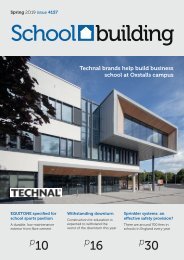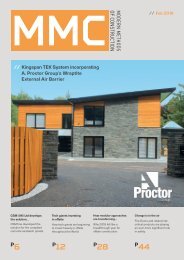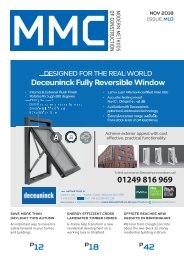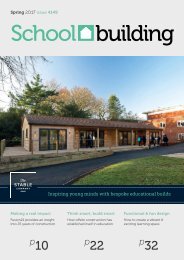R1 R&R Sept '16 52 cc
You also want an ePaper? Increase the reach of your titles
YUMPU automatically turns print PDFs into web optimized ePapers that Google loves.
Industry Voice<br />
Planning for future adaptation<br />
As in designing and constructing new build construction it is still somewhat unusual for the project team to give proper<br />
consideration to the practicalities of future refurbishment and possible reconfiguration. In most cases this is probably a shortsighted<br />
omission; Roisin Sweeney of Buildoffsite.com explains.<br />
Woodview Mews, built version of the LivinHome housing<br />
system (courtesy of Geraghty Taylor Architects)<br />
During the life of the building or<br />
structure it is entirely likely that work<br />
will need to be carried out to repair<br />
and replace services, to refurbish and possibly<br />
to carry out a complete reconfiguration<br />
because the building is no longer required for<br />
its original use or possibly because<br />
replacement technology needs to be<br />
incorporated.<br />
OK, there will always be ways to carry out the<br />
necessary work but this will inevitably be at an<br />
unpredictable cost and will likely be carried<br />
out over an extended period of time, when<br />
with up-front planning there could be a faster,<br />
more cost-effective approach.<br />
This opportunity to fast track is increasingly<br />
attractive to retailers who understand that it is<br />
both necessary to carry out regular<br />
refurbishment to ensure that the internal<br />
environment is attractive to customers, keeps<br />
up with corporate branding and that<br />
associated services - whether these be<br />
restaurants, changing facilities or back office<br />
installations - are attractive and efficient. The<br />
imperative for retailers will be to have the<br />
required works carried out as quickly as<br />
possible to their required standards. Extended<br />
periods of closure are highly undesirable if<br />
customer loyalty and revenue is to be retained.<br />
A number of the most enlightened retail<br />
clients are now working with Buildoffsite<br />
through a specially constituted Refurbishment<br />
Hub, to explore ways in which a fast-track<br />
approach to projects will provide for rapid<br />
dismantling and removal of existing<br />
installations, and the installation of offsite<br />
constructed replacement modules and<br />
components. Ensuring that the original design<br />
and service layout has had regard to the needs<br />
of refurbishment will ensure that limiting<br />
factors, such as the width of a<strong>cc</strong>ess points to<br />
perhaps allow for the skid mounted delivery,<br />
and installation of full size units, has been<br />
taken into a<strong>cc</strong>ount. This is not rocket science<br />
and there are plenty of examples of the<br />
approach in, for example, the exhibition,<br />
theatre/film and logistic sectors.<br />
Much the same set of considerations will apply<br />
to other building types where it is understood<br />
that there will be a need for predictable and<br />
efficient refurbishment. Hotel bedrooms,<br />
restaurants and public areas are obvious<br />
candidates for a planned fast track approach.<br />
However, similar challenges exist for, say,<br />
schools and hospitals and health facilities. In<br />
these cases the need for refurbishment is<br />
driven by changes in technology and in<br />
practice. In health, the rate of advance in<br />
clinical practice is so rapid that something of a<br />
revolution in enabling technology takes place<br />
every five years or so. Let’s just consider what<br />
this means in terms of the need to carry out<br />
major refurbishment to all those new facilities<br />
that have been provided over recent years at<br />
such huge cost to the public purse. The rate of<br />
change in educational practice is not so fast –<br />
nor possibly so disruptive – but it is still a<br />
relevant consideration.<br />
It is also a distinct possibility that opportunities<br />
will arise for fast track refurbishment in the<br />
housing sector. The concept of lifetime homes<br />
requires an approach to design and<br />
construction that allows for internal space to<br />
be reconfigured, possibly for additional<br />
modules to be installed and in due course<br />
removed, and also the opportunity for in-situ<br />
downsizing and upsizing.<br />
If we don’t think about this alternative<br />
approach then the inevitable consequence will<br />
be reliance on demolition, waste disposal and<br />
traditional forms of construction. All of which<br />
will involve excessive cost, excessive<br />
construction time and probably lower levels of<br />
quality.<br />
If you are interested in the opportunities<br />
provided by the adoption of a fast track<br />
approach to refurbishment then follow the<br />
work off the Buildoffsite Refurbishment<br />
Hub at their website.<br />
www.buildoffsite.com<br />
18 Refurb retrofit<br />
magazine<br />
Sep/Oct 2016 <strong>R1</strong>

















